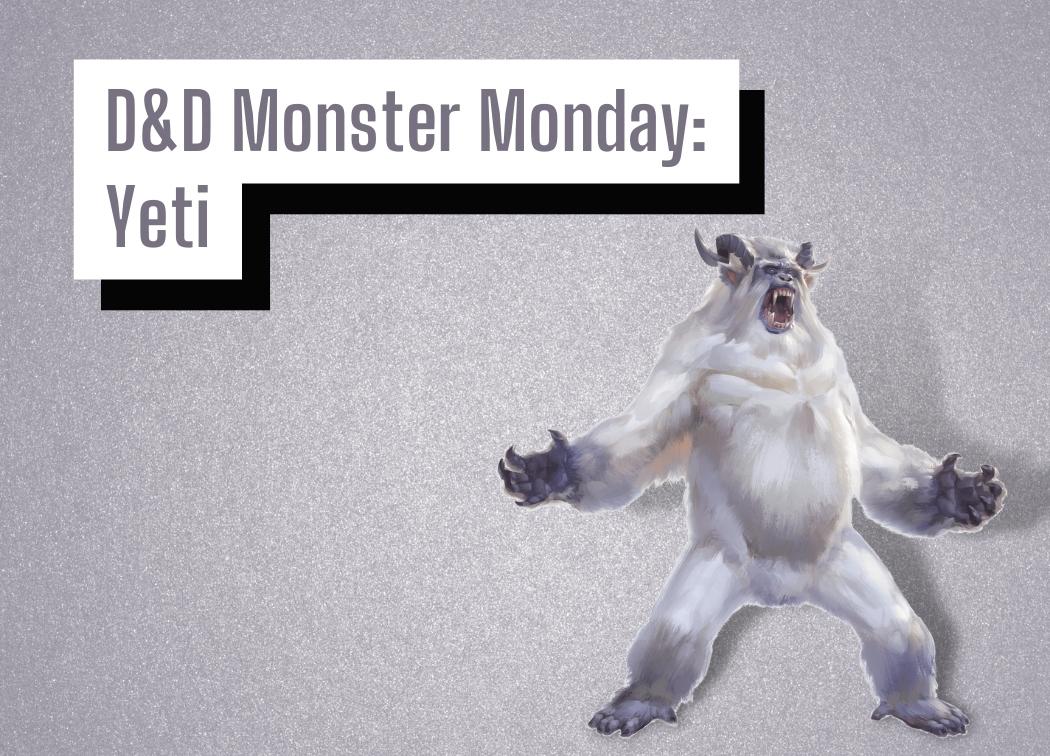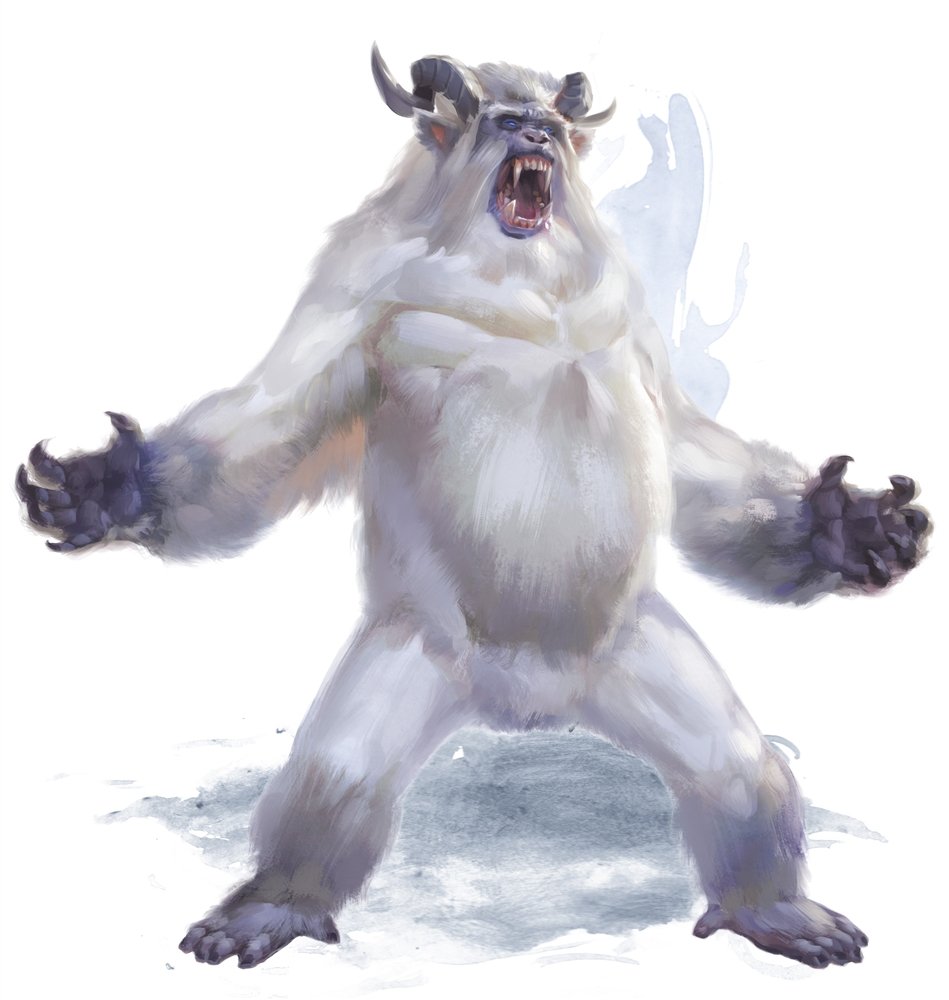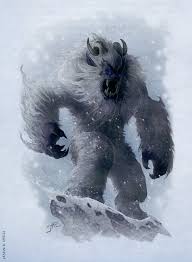D&D Monster Monday: Yeti

The frigid air chills you to the bone. You duck into a cave to wait out the blizzard. Big mistake. Before you can even strike the flint to light a fire, you are pounced on by an enormous yeti. You scream in agony as it tears into you, ripping flesh from bone. Frostbite would’ve been a more merciful opponent.
It would be sacrilege to have a wintery-themed Monster Monday miniseries and not include the yeti! There are two flavors of yeti in the 5e Monster Manual, but today we’re going to be focusing on the plain-old CR 3 version.
Don’t let your guard down, though. It may only be CR 3, but the yeti is a fearsome creature. Despite their large, lumbering appearance they are extremely quick. Plus, they have a reliable form of crowd control that they can use to quickly thin the party’s numbers.
This seemingly-unstoppable behemoth is a force to be reckoned with for low-level parties. Unless of course, they’re able to figure out and utilize the yeti’s embarrassing fear of fire to their advantage.
Put on your snowshoes and grab your canteen of hot chocolate because it’s time to trek through the Monster Manual and find us a yeti!

Yeti Lore
Yetis are hunters by nature, and successful ones at that. They have a renowned sense of smell making them expert trackers and a terrifying obstacle for mountain travelers to prepare for.
However, unlike other hunters in D&D such as the bugbear, the yeti prefers to hunt alone or with a small family group. They are solitary creatures that rely on ambushing their prey by using the snow as cover for their enormous bodies.
Usually, yetis and humans can live in harmony, provided that humans leave the local game population at a reasonable level. If that’s the case then the yetis will live their lives and dare not tread into any human territories. However, once a scarcity happens yetis will come charging into human towns and settlements, feasting upon whatever and whoever they can find.
Yetis, while considered monsters are very similar to beasts in regards to their psychology. If they are fed and not annoyed they won’t pose an issue to anyone else. It all comes back to the adage of “don’t poke the bear”!
Yeti Stats and Abilities
You can find the yeti’s statblock on page 305 of the Monster Manual.
Stats
Size: Large Monstrosity
AC: 12 (natural armor)
HP: 51 (6d10 + 18)
Speed: 40 ft., climb 40 ft.
STR: 18 (+4)
DEX: 13 (+1)
CON: 16 (+3)
INT: 8 (-1)
WIS: 12 (+1)
CHA: 7 (-2)
A low AC of 12 is expected. Yetis are not known for their dexterity after all. Plus, they don’t typically don armor, even if they have the physique to do so. Thankfully, though, their hit points are there to save the day with an ocean-like pool of health that the party will have to cleave through.
The yeti’s 40 ft. of movement speed and climbing speed was what surprised me. I expected the yeti to have a fair bit of climbing speed since they thrive in mountainous regions, but 40 ft. per turn surprised me.
All in all, their ability score array is decent. It includes everything that the yeti needs such as high Strength and Constitution, and it forgoes everything they don’t such as Intelligence and Charisma.
While their Dexterity, Constitution, and Wisdom aren’t terrible, the yeti’s Dexterity and Wisdom aren’t great either. All in all, their common saving throw ability modifiers are mediocre at best.
Resistances, Immunities, Saves, and Skills
Skills: Perception +3, Stealth +3
Damage Immunities: cold
Senses: darkvision 60 ft., passive Perception 13
Languages: Yeti
CR: 3 (700 XP)
The yeti is a hunter and a solitary one at that. There’s little room for error so they need to be fantastic at both locating and ambushing their prey. The bonuses to their Perception and Stealth checks certainly give them a bit of an edge in that department at least.
No one should be surprised that a creature who is at their peak in the middle of a blizzard is immune to cold damage. However, it is a fairly common damage type so this is quite the excellent damage immunity to have.
Thanks to their darkvision, a yeti can hunt at any time. If you’re traversing a snowy mountain range, you best prepare yourself!
CR 3 is a reasonable CR for the yeti, though they are a tad strong for it. Their mediocre defenses are propped up by their ability to soak a ton of damage with their high HP. Most importantly, however, they’re able to dish-out a truckload of damage to an enemy. Unsuspecting or otherwise.
Abilities and Traits
Fear of Fire. If the yeti takes fire damage, it has disadvantage on attack rolls and ability checks until the end of its next turn.
Keen Smell. The yeti has advantage on Wisdom (Perception) checks that rely on smell.
Snow Camouflage. The yeti has advantage on Dexterity (Stealth) checks made to hide in snowy terrain.
Fear of Fire is certainly a flavorful trait for the yeti to have. It certainly helps frame the yeti as a creature that typically leaves humans alone unless they are desperate for food. Mechanically speaking, though, this is a debilitating feature to have as a yeti against a group that has easy access to fire damage. Tread carefully!
Keen Smell just enhances the yeti’s already excellent Perception with regards to tracking their prey. It’s also a nice trait to have in a pinch if one of your targets becomes invisible in an attempt to flee!
Snow Camouflage sets up the yeti as an ambusher, provided that you’re fighting a yeti in an area with enough snowy terrain for them to hide in. They’re powerful enough on their own, but if you can pull off a successful ambush the yeti becomes a deadly creature to tangle with.
Actions
Multiattack. The yeti can use its Chilling Gaze and makes two Claw attacks.
Claw. Melee Weapon Attack: +6 to hit, reach 5 ft., one target. Hit: 7 (1d6 + 4) slashing damage plus 3 (1d6) cold damage.
Chilling Gaze. The yeti targets one creature it can see within 30 feet of it. If the target can see the yeti, the target must succeed on a DC 13 Constitution saving throw against this magic or take 10 (3d6) cold damage and then be paralyzed for 1 minute, unless it is immune to cold damage. The target can repeat the saving throw at the end of each of its turns, ending the effect on itself on a success. If the target’s saving throw is successful or if the effect ends on it, the target is immune to the Chilling Gaze of all yetis (but not abominable yetis) for 1 hour.
A three-attack Multiattack means that the yeti boasts a higher-than-average action economy for its CR. Keep in mind as well that the average damage of all three attacks is 30 per turn and includes crowd control in the form of temporary paralysis. That’s a fantastic Multiattack for a low-CR creature!
Claw is a solid attack that deals damage from two different damage types. Outside of that, it’s nothing remarkable, but it’s a respectable amount of consistent damage.
Chilling Gaze is a powerful ranged attack that can deal both a decent amount of cold damage as well as paralyze a target for up to 1 minute. The DC 13 Constitution saving throw is fairly forgiving all things considered, but it’s by no means an automatic pass.
Unlike similar abilities such as the banshee’s Horrifying Visage, if a target succeeds on Chilling Gaze’s saving throw then they are immune to EVERY yeti’s Chilling Gaze for 1 hour. This certainly helps to lessen the impact of what is a dangerous action to fail a saving throw against.
Yeti Strengths
Frighteningly Strong Damage and Action Economy
30 damage spread between three attacks and two different damage types is a hefty amount of damage for a CR 3 creature.
The yeti’s action economy is buck-wild. For most creatures around CR 3, a Multiattack will typically consist of 2 separate attacks so having 3 puts them ahead of the curve. We also need to consider the fact that one of these attacks can also cause the target to be Paralyzed.
Paralyzing your foe in 5e means that they both effectively lose their turn unless they can break out of the paralysis and attacks made against them are made at advantage. This, in turn, increases the yeti’s survivability and damage output.

Yeti Be Nimble, Yeti Be Quick
For a large creature, the yeti is anything but a lumbering oaf. Yetis are deceptively fast with their 40 ft. of movement creatures and expert climbers as well!
They sort of have to be so quick and nimble too. If your source of food is found by hunting creatures that thrive in cold and rocky landscapes, you need to be just as adept at climbing around the rocky terrain as well.
Also, keep in mind that they have Snow Camouflage so once the yeti has tracked the party down, they can hide and ambush the unsuspecting travelers at an opportune moment!
A Blubbery Tank
“Didn’t I ever tell you about bumbles? Bumbles Bounce!” -Yukon Cornelius
An AC of 12 isn’t doing our yeti friends any favors, but despite their low AC yetis are still respectable tanks that will soak a ton of damage before they drop.
The yeti’s average HP of 51 is an enormous pool of health to draw from for any low-level party. Fighting one or two of these creatures will certainly force the party to expend a fair number of their resources unless they have the right tools for the job.
Not only that, but they also have an immunity to cold damage which, while easily assumed, is still a common damage type for low-level spells. This can seriously limit a spellcaster’s usefulness if they have been banking on Ray of Frost or Ice Knife.
Yeti Weaknesses
Caught on Fire? The Situation is Dire!
The yeti does have one weakness and it’s a glaring one at that. Fear of Fire is about as obvious of an Achilles’ Heelas you could imagine.
If the party is smart enough to shoot some Fire Bolts at the yetis then they will reap the benefits of forcing the afflicted yeti(s) to attack and make ability checks at disadvantage.
However, you don’t need a magic-user to even reap the benefits of this weakness. If a party member spends a whole action to attack with a lit torch and deals even just 1 point of fire damage to the yeti, they immediately suffer the effects of Fear of Fire.
It’s a flavorful weakness and quite frankly, a necessary one since this creature would be a menace without some sort of weakness.
How to Play a Yeti
Expert Hunter
Any encounter with a yeti will be deadly if you can get the drop on the party thanks to Keen Smell and Snow Camouflage. That extra surprise round will be the perfect vessel for stomping an unsuspecting party member with your Claw and Chilling Gaze attacks.
The benefit of this tactic is that the yeti will have time to scout out an opportune location to fight the party. This would be somewhere that the party can’t easily kite the yeti around the battlefield or stand out of range of Chilling Gaze.
With that being said, it’s fairly challenging to kite a yeti around any battlefield due to their 40 ft. of movement speed which is 10-15 higher than the average player character. Don’t plop a yeti in the middle of a large flat field and they’ll do pretty well.

Rampage & Riot
However, the yeti doesn’t require a surprise round to be a complete menace to the party. Their above-average damage and fantastic action economy are already reason enough to flee from a yeti’s cave. The way I see it, a yeti has one of two options.
The first is that the yeti can use Chilling Gaze to subdue one of the party’s frontline characters so they can use their 40 ft. of movement to barrel into the party’s squishy backline spellcasters and ranged attackers.
On the other hand, if the party is particularly beefy then your yetis may want to instead use their Chilling Gaze on the party’s backline so they can spend time clawing through the well-armored fighters. This is also a solid tactic to use to prevent the party’s spellcasters from dealing fire damage and thus activating Fear of Fire.
5 Yeti Plot Hooks
- Ho Ho OH NO! – A portly elf has made the trek down the mountain to deliver presents to children for hundreds of years. This year, however, all of his prized reindeer have been devoured by some terrifying beast.
- The Art of War – A foreign conqueror seeks to seize the towns and villages within the mountainscape. However, rather than risk their own forces they have decided to decimate the mountain’s game population and force the yetis to hunt the townspeople out of desperation.
- Return to the Pack – While treking through the mountains you heard a tiny squeaking behind some rocks. Upon further inspection you found a lost, and scared baby yeti. It won’t survive long alone, and you’re certainly not equipped to take care of them.
- A Chistmas Bonus – Fashion changes on a dime and this year yeti fur is IN. You can fetch a great price for supplying the local tannery with yeti pelts.
- Exiled – Once an important member of society, the yeti was forced into exile in the cold mountains to the north. No one has heard from them for years now. Why did they leave, and where are they now?
Conclusions
The yeti, unlike the Bumble, is a terrifying creature to find yourself in combat with. Especially as a low-level character trying to weather the rough terrain of a snowy mountainscape.
Yeti’s deal a terrifying amount of damage, are frighteningly quick, and can take a boatload of attacks before the keel over. These are not the cute little creatures from Christmas movies, that’s for sure!
The yeti’s one weakness is hard-coded into their statblock. Fear of Fire heavily reduces the yeti’s impressive damage output as well as their ability to make skill checks. A quick-thinking party can turn the tables on a group of yetis once they discover this weakness.
Just make sure that if you find yourselves stuck traversing the mountains in the middle of a blizzard you keep your weapons easily accessible. Yetis are dangerous!
